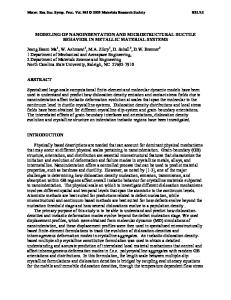Hierarchical modeling of nanoindentation and microstructural evolution of face-centered cubic gold aggregates
- PDF / 8,959,486 Bytes
- 17 Pages / 585 x 783 pts Page_size
- 30 Downloads / 277 Views
D.W. Brenner Department of Materials Science, North Carolina State University, Raleigh, North Carolina 27606 (Received 23 April 2006; accepted 24 October 2006)
A hierarchical computational method has been developed and used with a finite-element microstructurally based dislocation density multiple-slip crystalline formulation to predict how nanoindentation affects behavior in face-centered cubic crystalline aggregates at scales that span the molecular to the continuum level. Displacement profiles from molecular dynamics simulations of nanoindentation were used to obtain scaling relations, which are based on indented depths, grain-sizes, and grain aggregate distributions. These scaling relations are then used to coarsen grains in a microstructurally based finite-element formulation that accounts for dislocation density evolution, crystalline structures, and grain-sizes. This computational approach was validated with a number of experimental measurements pertaining to single gold crystals. This hierarchical model provides a methodology to link molecular level simulations with a microstructurally based finite element method formulation that can be used to ascertain inelastic effects, such as shear-slip distribution, pressure accumulation, and dislocation density and slip-rate evolution at physical scales that are commensurate with ductile behavior at the microstructural scale.
I. INTRODUCTION
The synthesis, processing, analysis, and design of nanostructured materials require accurate material properties and a detailed understanding of material behavior at different physical scales. As nanocrystalline grainsizes are refined, one of the few available experimental techniques to accurately assess material properties is nanoindentation, which can be utilized to determine material hardness and elastic and inelastic response. However, reliable nanoindentation measurements of material properties of nanocrystalline materials have been severely hampered by an inability to account for different physical mechanisms, such as grain-boundary (GB) effects, dislocation activities, and GB sliding that span different scales in ductile materials. Numerous studies have clearly indicated that inelastic behavior is difficult to characterize by nanoindentation due to localized dislocation activities over small volumes that can be dominated a)
Address all correspondence to this author. e-mail: [email protected] DOI: 10.1557/JMR.2007.0076 J. Mater. Res., Vol. 22, No. 3, Mar 2007
http://journals.cambridge.org
Downloaded: 13 Mar 2015
by a large fraction of GB surfaces (see, for example, Ref. 1). Furthermore, crystalline aggregates, which can be composed of a collection of nanograins, can approach micro scales. Hence, the transition from the nano to the micro level behavior needs to be better understood and accurately predicted, such that indentation can be used to accurately predict material behavior for the potential tailoring of crystalline aggregates for desired applications. The accurate measurement of the hardness of bulk and thin film
Data Loading...











